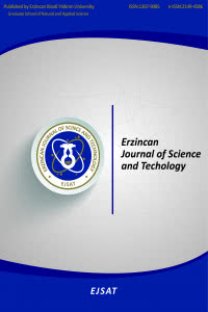Vinca soneri'den İzole Edilen Loganic Asidin Probiyotik Bakteriler Lactobacillus acidophilus ve Lactobacillus rhamnosus'un Yüzey Hidrofobisitesi ve Oto-Agregasyonu Üzerine Etkileri
Effects of Loganic Acid isolated from Vinca soneri on Surface Hydrophobicity and AutoAggregation of Probiotic Bacteria, Lactobacillus acidophilus and Lactobacillus rhamnosus
___
- Bahadori, F. (2012). Vinca alkaloitlerinin Vinca türlerinden izolasyonu ve yapı tayini ve vinorelbine yüklenmiş nano-ilaç taşıma sistemlerinin sitotoksik aktivitelerinin araştırılması (Doctoral dissertation, İstanbul Teknik Üniversitesi, Fen Bilimleri Enstitüsü).
- Baytop, T., 1999. Therapy with medicinal plants in Turkey: Past and Present. Nobel Tıp Kitabevi, Istanbul.
- Bianco, A., Guiso, M., Passacantilli, P., & Francesconi, A. (1984). Iridoid and phenypropanoid glycosides from new sources. Journal of Natural Products, 47(5), 901-902.
- Bustos, I, García-Cayuela T, HernándezLedesma B, Peláez C, Requena T, MartínezCuesta MC. 2012. Effect of flavan-3-ols on the adhesion of potential probiotic lactobacilli to intestinal cells. J. Agric. Food Chem. 60:9082–88
- Celebioglu, HU, Delsoglio M, Brix S, Pessione E, Svensson B. 2018. Plant polyphenols stimulate adhesion to intestinal mucosa and induce proteome changes in the probiotic Lactobacillus acidophilus NCFM. Mol. Nutr. Food Res. 62(4):1–11
- Celebioglu, HU, Ejby M, Majumder A, Købler C, Goh YJ, et al. 2016. Differential proteome and cellular adhesion analyses of the probiotic bacterium Lactobacillus acidophilus NCFM grown on raffinose - an emerging prebiotic. Proteomics. 16(9), 1361- 1375.
- De Souza EL, de Albuquerque TMR, dos Santos AS, Massa NML, de Brito Alves JL. 2019. Potential interactions among phenolic compounds and probiotics for mutual boosting of their health-promoting properties and food functionalities–A review. Crit. Rev. Food Sci. Nutr. 59(10):1645–59
- Dei, L., Li, N., Zu, L. B., Wang, K. J., Zhao, Y. X., & Wang, Z. (2011). Three new iridoid glucosides from the roots of Patrinia scabra. Bull. Korean Chem. Soc, 32(9), 3251.
- Del Carmen Recio M, Giner RM, Manez S, Rios JL. 1994. Structural considerations on the iridoids as anti-inflammatory agents. Planta Med. 60(3):232–34
- dos Santos AS, de Albuquerque TMR, de Brito Alves JL, de Souza EL. 2019. Effects of quercetin and resveratrol on in vitro properties related to the functionality of potentially probiotic Lactobacillus strains. Front. Microbiol. 10(September):1–13
- Hill C, Guarner F, Reid G, Gibson GR, Merenstein DJ, et al. 2014. Expert consensus document: The International Scientific Association for Probiotics and Prebiotics consensus statement on the scope and appropriate use of the term probiotic. Nat. Rev. Gastroenterol. Hepatol. 11(August 2014):9
- Kos B, Susković J, Vuković S, Simpraga M, Frece J, Matosić S. 2003. Adhesion and aggregation ability of probiotic strain Lactobacillus acidophilus M92. J. Appl. Microbiol. 94(6):981–87
- Koyuncu, M., Ekşi, G., & Özkan, A. M. G. (2015, August). Vinca ispartensis (Apocynaceae), a new species from Turkey. In Annales Botanici Fennici (Vol. 52, No. 5– 6, pp. 340-345). Finnish Zoological and Botanical Publishing Board.
- Koyuncu, M. (2012). A new species of Vinca (Apocynaceae) from eastern Anatolia, Turkey. Turk. J. Bot., 36(3), 247-251.
- Krasowska A, Sigler K. 2014. How microorganisms use hydrophobicity and what does this mean for human needs? Front. Cell. Infect. Microbiol.,4,112.
- Lebeer S, Vanderleyden J, De Keersmaecker SCJ. 2008. Genes and molecules of lactobacilli supporting probiotic action. Microbiol. Mol. Biol. Rev. 72(4):728–64.
- Mills S, Stanton C, Fitzgerald GF, Ross RP. 2011. Enhancing the stress responses of probiotics for a lifestyle from gut to product and back again. Microb. Cell Fact. 10 Suppl 1(Suppl 1):S19
- Puupponen-Pimia R, Aura AM, OksmanCaldentey K-M, Myllarinen P, Saarela M, et al. 2002. Development of functional ingredients for gut health. Trends Food Sci. Technol. 13:3–11
- Sanders ME, Klaenhammer TR. 2001. Invited review: the scientific basis of Lactobacillus acidophilus NCFM functionality as a probiotic. J. Dairy Sci. 84(2):319–31
- Sezer, E. N. Ş., Uysal, T. Volatile and Phenolic Compositions of the leaves of two Vinca L. species from Turkey. Current Perspectives on Medicinal and Aromatic Plants (CUPMAP), 1(2), 103-110.
- Spiller R. 2008. Probiotics and prebiotics in irritable bowel syndrome. Aliment. Pharmacol. Ther. 28, 385–396.
- Şöhretoğlu, D., Masullo, M., Piacente, S., & Kirmizibekmez, H. (2013). Iridoids, monoterpenoid glucoindole alkaloids and flavonoids from Vinca major. Biochem. Syst. and Ecol., 49, 69-72.
- Wei S, Chi H, Kodama H, Chen G. 2013. Anti-inflammatory effect of three iridoids in human neutrophils. Nat. Prod. Res. 27(10):911–15
- Yadav H, Lee JH, Lloyd J, Walter P, Rane SG. 2013. Beneficial metabolic effects of a probiotic via butyrate-induced GLP-1 hormone secretion. J. Biol. Chem. 288(35):25088–97
- ISSN: 1307-9085
- Yayın Aralığı: 3
- Başlangıç: 2008
- Yayıncı: Erzincan Binali Yıldırım Üniversitesi, Fen Bilimleri Enstitüsü
Dielektrik Spektroskopi ile Üleksitin Elektriksel Özellikleri
Bir Topolojik Halkada Kaba Yaklaşım Operatörleri
Fredholm İntegro Diferansiyel Denklemin Sayısal Çözümü için Alternatif Bir Yöntem
Benzoksazolon Türevi Şalkon Bileşiklerinin Sentezi ve Biyoaktivitelerinin Araştırılması
Polipropilen Lif Katkılı Kerpiç Tuğlaların Fiziksel ve Mekanik Özelliklerinin İncelenmesi
